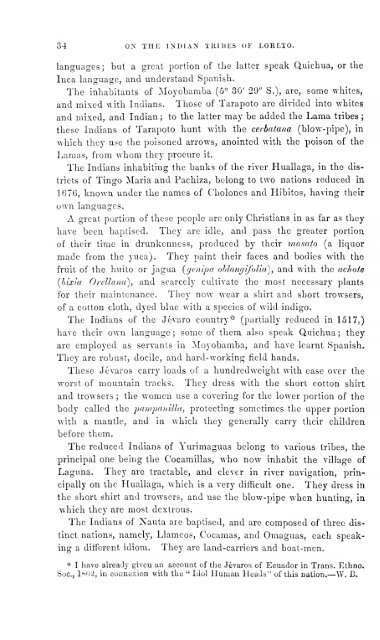The anthropological review - National Library of Scotland
The anthropological review - National Library of Scotland
The anthropological review - National Library of Scotland
Create successful ePaper yourself
Turn your PDF publications into a flip-book with our unique Google optimized e-Paper software.
34 ox THE INDIAN TlilBES OF LORETO.<br />
languages ; but a great portion <strong>of</strong> the latter speak Quichua, or the<br />
Inca language, and understand Spanish.<br />
<strong>The</strong> inhabitants <strong>of</strong> Moyobanaba (5° 30' 29" S.), are, some whites,<br />
and mixed with Indians. Those <strong>of</strong> Tarapoto are divided into whites<br />
and mixed, and Indian ; to the latter may be added the Lama tribes<br />
these Indians <strong>of</strong> Tarapoto hunt with the cerbatana (blow-pipe), in<br />
which they use the poisoned arrows, anointed with the poison <strong>of</strong> the<br />
Lamas, from whom they procure it.<br />
<strong>The</strong> Indians inhabiting the banks <strong>of</strong> the river Huallaga, in the dis-<br />
tricts <strong>of</strong> Tingo Maria and Pachiza, belong to two nations reduced in<br />
1676, known under the names <strong>of</strong> Cholones and Hibitos, having their<br />
own languages.<br />
A great portion <strong>of</strong> these people are only Christians in as far as they<br />
have been baptised. <strong>The</strong>y are idle, and pass the greater portion<br />
<strong>of</strong> their time in drunkenness, produced by their masato (a liquor<br />
made from the yuca). <strong>The</strong>y paint their faces and bodies with the<br />
fruit <strong>of</strong> the huito or jagua {genipa ohlongifolia), and with the achote<br />
{bixia Orelland), and scarcely cultivate the most necessary plants<br />
for their maintenance. <strong>The</strong>y now wear a shirt and short trowsers,<br />
<strong>of</strong> a cotton cloth, dyed blue with a species <strong>of</strong> wild indigo.<br />
<strong>The</strong> Indians <strong>of</strong> the Jevaro country ^^ (partially reduced in 1517,)<br />
have their own language ; some <strong>of</strong> them also speak Quichua ; they<br />
are employed as servants in Moyobamba, and have learnt Spanish.<br />
<strong>The</strong>y are robust, docile, and hard-working field hands.<br />
<strong>The</strong>se Jevaros carry loads <strong>of</strong> a hundredweight with ease over the<br />
worst <strong>of</strong> mountain tracks. <strong>The</strong>y dress with the short cotton shirt<br />
and trowsers ; the women use a covering for the lower portion <strong>of</strong> the<br />
body called the pampanilla, protecting sometimes the upper portion<br />
with a mantle, and in which they generally carry their children<br />
before them.<br />
<strong>The</strong> reduced Indians <strong>of</strong> Yurimaguas belong to various tribes, the<br />
principal one being the Cocamillas, who now inhabit the village <strong>of</strong><br />
Laguna. <strong>The</strong>y are tractable, and clever in river navigation, prin-<br />
cipally on the Huallaga, which is a very difficult one. <strong>The</strong>y dress in<br />
the short shirt and trowsers, and use the blow-i^ipe when hunting, in<br />
•which they are most dextrous.<br />
<strong>The</strong> Indians <strong>of</strong> Nauta are baptised, and are composed <strong>of</strong> three dis-<br />
tinct nations, namely, Llameos, Cocamas, and Omaguas, each speak-<br />
ing a different idiom. <strong>The</strong>y are land-carriei-s and boat-men.<br />
* I have already given an account <strong>of</strong> the Jevaros <strong>of</strong> Ecuador in Trans. Ethno.<br />
See, 1802, in counexion with the " Idol Human Heads" <strong>of</strong> this nation.—W. B.<br />
;

















